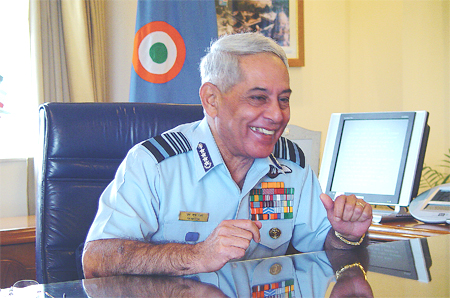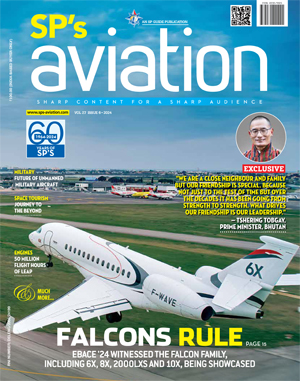INDIAN ARMED FORCES CHIEFS ON
OUR RELENTLESS AND FOCUSED PUBLISHING EFFORTS

SP Guide Publications puts forth a well compiled articulation of issues, pursuits and accomplishments of the Indian Army, over the years

I am confident that SP Guide Publications would continue to inform, inspire and influence.

My compliments to SP Guide Publications for informative and credible reportage on contemporary aerospace issues over the past six decades.
Air Force Chief - Credibility exists only if there’s Demonstrated Capability

Chief of the Air Staff Air Chief Marshal F.H. Major, spoke to Editor-in-Chief Jayant Baranwal and Senior Visiting Editor Air Marshal (Retd) V.K. Bhatia. The first installment of a two-part series features excerpts of the discussion focusing largely on operations, acquisitions and upgradations.
SP’s Aviation (SP’s): Having commanded one of the largest battle-tested air forces in the world for almost a year and half, what would you reckon are your greatest challenges?
Chief of the Air Staff (CAS): The Indian Air Force (IAF) is one of the largest air forces in the world and bears an immense regional responsibility. The IAF is at present in the midst of large scale modernisation. Almost every facet of our capability is being systematically addressed. The entire range of equipment, including aircraft, sensors, weapons, communication systems, air defence weapons, maintenance facilities and airfield infrastructure, are being inducted, modernised or upgraded in accordance with our overall plans.
My biggest challenge is managing the organisation during this moment of transition. At the present moment, a large proportion of our equipment inventory is either being inducted, phased-out, upgraded or replaced. Traditional methods of employment and maintenance of legacy items now have to co-exist with modern practices and structures. These processes work at different speeds, creating friction and interference, and demand management skills of a high order. The other challenge is to prepare and shape the IAF for the large scale modernisation taking place, and absorb the new technologies. I am conscious of the fact that the foundations laid down today will have an effect on the state of the IAF in the future. It is my endeavour to ensure that the equipment is inducted properly, personnel are trained, doctrines and tactics updated, and appropriate maintenance facilities and competence developed. These are very exciting times for the IAF. We will look and operate very differently, 10 years hence.
SP’s: What other major operational challenges do you foresee and how, in your opinion, should the IAF cope with them?
CAS: The modernisation drive will provide us with enhanced capabilities which will require revision of doctrines, tactics, training and structures. There are a number of accompanying operational challenges that will emerge and we are in the process of addressing them. To enable seamless integration of all combat assets on a suitable network, firstly to exploit them optimally and secondly to reduce our response and decision times, we will have to change our existing Standard Operating Procedures considerably. We have laid great focus on the development of the Integrated Air Command and Control System (IACCS) and the Air Force Network. It will provide us with huge bandwidth and widespread connectivity, and our command and control systems will ride on this network. Implementing this system and putting it into effective practice is one of my challenges. We need to harness the potential of space-based assets and put in place structures and mechanisms.
New technologies, whilst enhancing our capability, also generate some vulnerabilities. Today, the operational environment is dominated by long range sensors and weapons, which are orchestrated by complex networks and fast moving intelligence. This has created new vulnerabilities and targets of a different kind. Space, cyberspace and information warfare are the new zones of conflict, and we are in the process of developing doctrines, structures, tactics and expertise to dominate these new arenas. The IAF has great innate potential and a wonderful record of absorbing technologies and exploiting them in ways that were not even imagined by their designers. I am confident that these challenges will be addressed and the changes absorbed, making the IAF a very potent force in the future.
SP’s: What are your views of the technology-driven transformation process that is currently under way in the IAF?
CAS: Technology is indeed galloping ahead and Commercial Off-the-Shelf equipment sometimes exceeds military requirements. The IAF seeks to turn this fact into an advantage. We seek to obtain the best and latest equipment and utilise our innate capability to modify, improvise and integrate them to obtain world class products. The upgrades on the Bison, MiG-27 and the Jaguar have been success stories and are a testimony to this fact. A similar case is with the Su-30MKI, which has been tailored to our requirements, to suit our context. Technology today provides us with a variety of possibilities, and exploitation is limited only by the imagination of the user. We seek to identify specific technologies that serve to enhance our capabilities and acquire them in time.





